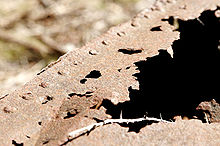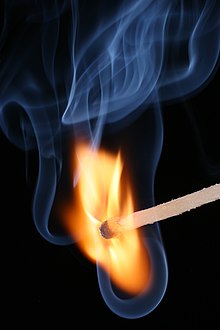oxidation

The oxidation (rarely also oxidation ) is a chemical reaction in which an atom , ion , or molecule electron emits. Its oxidation number is increased. Another substance absorbs the electrons and is reduced . Both reactions together are viewed as partial reactions of a redox reaction .
- Oxidation:
- Substance A releases n electrons.
history
The term oxidation was originally coined by the chemist Antoine Laurent de Lavoisier , who wanted to describe the union of elements and chemical compounds with the element oxygen (Oxygenium, French: oxygène), i.e. the formation of oxides .
The term was later expanded to include reactions in which hydrogen atoms were removed from a compound ( dehydrogenation ). So z. For example, in many biochemical processes, hydrogen atoms are “torn away” from organic compounds by certain coenzymes (NAD, NADP, FAD).
On the basis of ion theory and Bohr's atomic model , the oxidation could finally be interpreted and generalized from the point of view of electron theory. The characteristic of this process is now seen in the electron release of a chemical substance.
Oxidation by oxygen

Original meaning
Oxidation in the original sense used to be the chemical reaction of a substance with oxygen. Oxidations with the appearance of flames are called combustion or fire. This also includes the fireworks .
Classic examples
Classic examples of oxidation by oxygen are all types of combustion of carbon-containing substances under atmospheric oxygen , e.g. combustion of coal , wood, natural gas , liquid gas , petrol in engines , candles , etc. Starting from coal (pure carbon), each carbon atom gives four electrons to two oxygen atoms to form two double bonds . The result is carbon dioxide (CO 2 ).
- Carbon + oxygen → carbon dioxide
In the body, food is oxidized in the many steps of the biochemical metabolism to, among other things, the body's own substances, carbon dioxide (CO 2 ) and water. One example is the β-oxidation of fatty acids. Also the enzymatic browning is due to oxidation. Not only in vivo , but also in vitro , organic substances can react with oxygen in a variety of ways: A primary alcohol ( alkanol ) is gently oxidized. In the process, an aldehyde ( alkanal ) is formed first , and when it is oxidized again a carboxylic acid ( alkanoic acid ). If the oxidation is more vigorous, the step to the aldehyde can be skipped, so that the oxidation of the primary alcohol leads directly to the isolation of a carboxylic acid. If a secondary alcohol is oxidized, a ketone ( alkanone ) is formed. Tertiary alcohols cannot be oxidized to a carbonyl compound because of the three carbon bonds they already have.
Iron rusts ( corrodes ) under the influence of oxygen and forms various iron oxides ( rust , Fe 2 O 3 , Fe 3 O 4 , FeO). Aluminum is covered with a protective layer of aluminum oxide through air oxidation .
The reaction of hydrogen with oxygen (see oxyhydrogen ) produces water ( hydrogen oxide , H 2 O):
- Hydrogen + oxygen ( oxyhydrogen ) react to form water
Modern definition
Even today, the term oxidation is often associated with the reaction with (atmospheric) oxygen and the formation of oxides. However, in the context of the more general definition, this reaction is only one of many that can be explained with the help of the valence electron theory.
Reacts e.g. B. a metal atom with an oxygen atom, one can understand the oxidation of the metal and thus the metal oxide formation using the following reaction equations:
- Oxidation:
- Oxidation: The metal M gives off two electrons.
- Reduction:
- Reduction: Oxygen takes on two electrons per atom.
- Redox reaction: Oxygen oxidizes the metal and is itself reduced in the process.
In this case, oxygen tends to build up a stable valence electron shell with a total of eight electrons by absorbing two electrons ( octet rule ). The metal, in turn, can dissolve partially occupied shells by releasing the electrons and thus reach the next lower stable electron configuration .
Oxidation without oxygen
The expanded term of oxidation is now applied to reactions that proceed according to the same chemical principle, even if no oxygen is involved. In this broader sense, oxidation means giving up electrons . For example, when sodium and chlorine react to form sodium chloride, the sodium atom donates an electron to the chlorine atom, so sodium is oxidized. In return, chlorine is reduced.
- Oxidation partial reaction
- Sodium gives off an electron.
- Partial reaction reduction
- In return, chlorine is reduced by absorbing an electron.
- Overall response
- Sodium and chlorine react with each other in a redox reaction.
Since chlorine only enters the reaction in molecular form as Cl 2 , it is correctly written stoichiometrically :
Web links
Individual evidence
- ^ IUPAC . Compendium of Chemical Terminology, 2nd ed. (The "Gold Book"). Compiled by AD McNaught and A. Wilkinson, Blackwell Scientific Publications, Oxford (1997), doi: 10.1351 / goldbook.O04362 .
- ^ Ulrich Lüning: Organic reactions , 2nd edition, Elsevier GmbH, Munich, 2007, p. 145, ISBN 978-3-8274-1834-0 .
- ^ Hans Beyer and Wolfgang Walter : Organic Chemistry , S. Hirzel Verlag, Stuttgart, 1984, p. 201, ISBN 3-7776-0406-2 .










